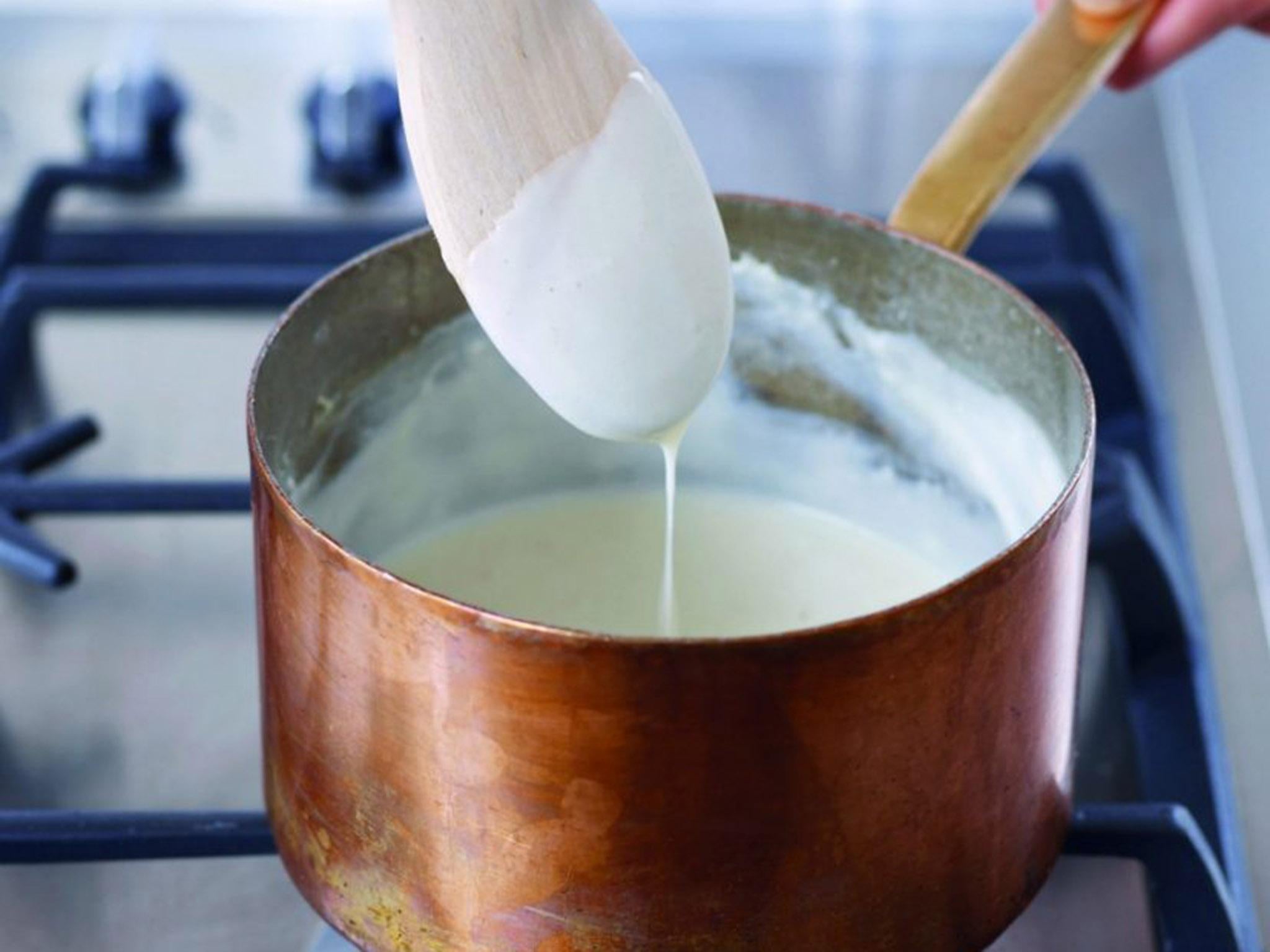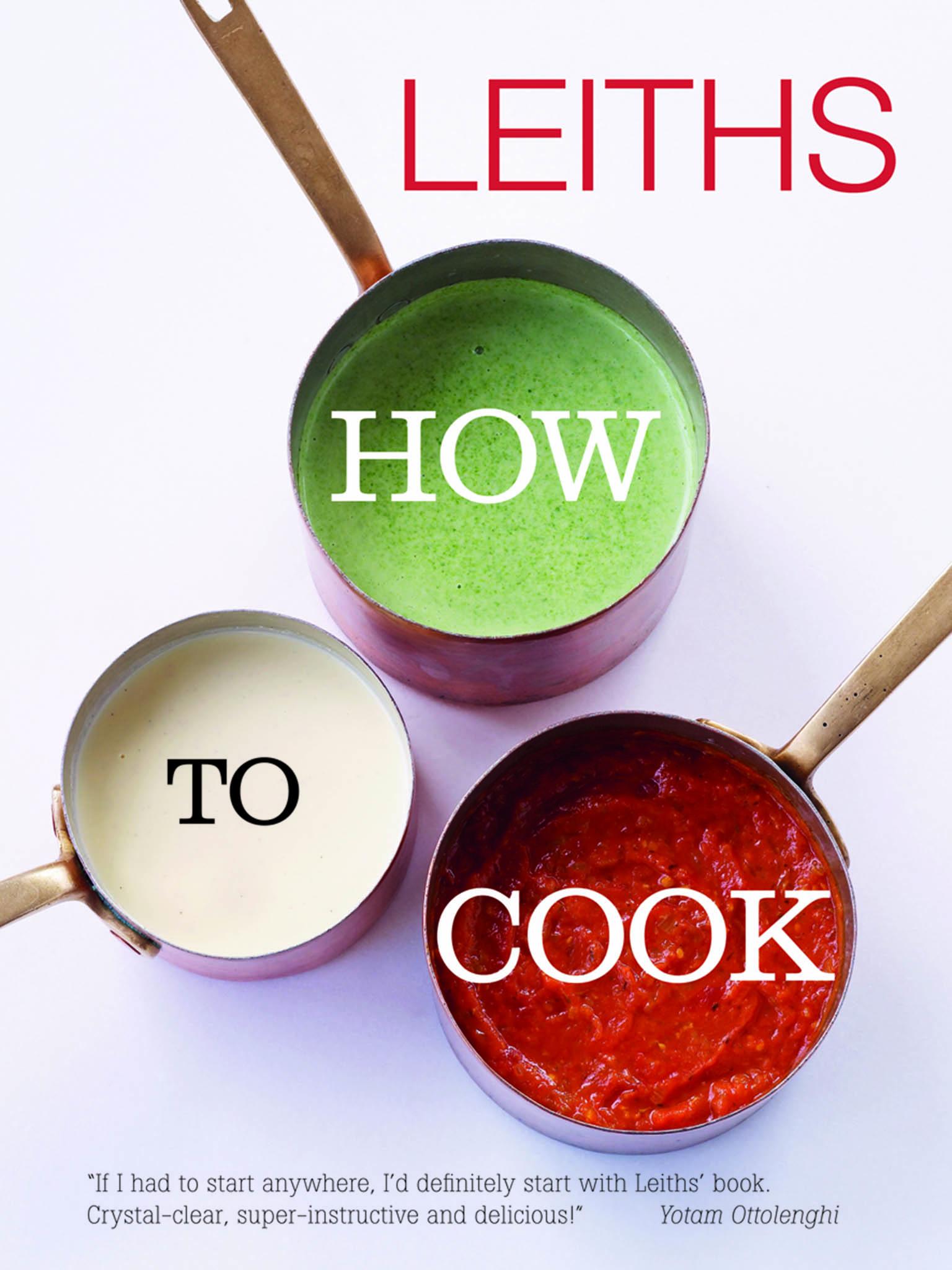Leiths' guide to making traditional sauces
It is possible for a slab of meat or fish to be complete without a sauce but then the right sauce can transport that meal into another galaxy

Traditional sauces
These are classic accompaniments to various red meats, poultry, game and fish. They are also useful when a quick sauce is needed to enhance a simple dish. A grilled pork loin chop is transformed by a spoonful of apple sauce; adding horseradish to mash boosts a braised-beef dish. Sometimes a cooling effect is required, and raita offers a soothing contrast to rich, spiced lamb dishes.
Apple sauce
Makes 150-200ml
450g (2 medium) bramley apples
3 tbsp water
2 tsp sugar
½ unwaxed lemon
Cooking apples, such as bramley, have a natural sharpness that packed-lunch apples lack, and which acts as a foil to the richness of pork.
1. Wash, peel and core the apples and put them into a medium saucepan with the water and sugar. Finely grate the zest from the lemon and add to the pan.
2. Cook over a very gentle heat until the apples have softened and lost their shape. Stir to break them up, taste and add more sugar if necessary.
Variations
Apple and sage sauce: Chiffonade 3-4 sage leaves and stir through the finished sauce.
Bramley and cox apple sauce: Once the Bramleys are soft, add 1 peeled, cored and very finely diced cox apple. The diced cox will hold their shape and give the sauce texture.
Bread sauce
An ideal accompaniment to roast chicken and turkey.
Makes 300ml
1 large onion
6 cloves
300ml milk
1 bay leaf
10 white peppercorns or a pinch of ground white pepper
Pinch of freshly grated nutmeg
60g-80g fresh coarse, white breadcrumbs, depending on desired thickness
50g butter
Salt and ground white pepper
1. Cut the onion in half, peel it and stud each half with the cloves. Place in a saucepan with the milk, bay leaf, pepper and nutmeg.
2. Scald the milk by heating it over a medium heat until steaming. Just before it bubbles, remove from the heat and leave to infuse for at least 30 minutes.
3. Strain the infused milk into a clean saucepan, discarding the aromatics. Reheat over a low to medium heat and add the breadcrumbs. The breadcrumbs will absorb the milk, thickening the sauce.
4. Stir the butter through to enrich the sauce. If the sauce is too thick, add a little warm milk; it should be spoonable, but not runny. Taste and season generously. Serve warm.
Note: You can make the sauce in advance, up the point where you have added the breadcrumbs and thickened the sauce. Cube the butter and dot it over the surface of the sauce, allowing it to melt and create a buttery film over the sauce. This will help to prevent a skin from forming. When ready to serve, reheat the sauce and stir the butter through. Taste and season.
Mint sauce
The classic accompaniment to roast lamb.
Makes 100ml
½ bunch of mint
2 tbsp caster sugar
2 tbsp hot water
2 tbsp white wine vinegar
1. Wash the mint and dry it. Pick the leaves off the stalks and discard the stalks. Finely chop or chiffonade the mint leaves and place in a bowl with the sugar.
2. Add the hot water and leave to stand for 5 minutes to allow the sugar to dissolve. Add the vinegar and infuse for a couple of hours. Taste and adjust with more sugar or vinegar.
Cranberry and orange sauce
This is traditionally served with roast turkey.
Makes 500ml
2 oranges
200g caster sugar
500g cranberries
1. Finely pare the zest from 1 orange in broad strips, using a swivel vegetable peeler, and then cut the zest into julienne. Squeeze the juice from both fruit.
2. Put the orange juice, zest julienne and sugar in a heavy-based saucepan and heat gently to dissolve the sugar and soften the zest.
3. Add the cranberries and simmer very slowly until they are becoming tender and just to starting to break up. Remove from the heat and let cool before serving.
Horseradish sauce
A classic accompaniment for roast beef and beef steaks.
Makes 200ml
½ horseradish root
75ml double cream
75ml creme fraiche
1-2 tsp white wine vinegar
½ tsp prepared English mustard
Salt and ground white pepper
1. Wash, peel and finely grate the horseradish; you will need about 2-3 tbsp grated.
2. Mix all the ingredients together in a bowl and leave to infuse for a few hours (or ideally overnight), to allow the strength of the horseradish to develop.
A note on fresh horseradish…
Fiendishly hot, horseradish is a creamy-coloured root that requires washing and peeling. Grate the outer, softer flesh first and use the inner root only if it is not too woody (as it can become, particularly late in the season).
Fresh horseradish root is not always available. When you do find it, grate the whole root and freeze any spare in small quantities. You can also buy it grated and preserved.
Mustard and dill sauce
The classic accompaniment to gravadlax (home-cured salmon), this also goes well with lamb.
Makes 120ml
Half a bunch of dill
1 tbsp Dijon mustard
90ml sunflower oil
1½ tbsp white wine vinegar
1 tsp caster sugar
Salt and freshly ground black pepper
1. Remove the dill leaves from the stalks and finely chop, discarding the stalks. You need about 3-4 tbsp.
2. Place the mustard in a small bowl and gradually whisk in the oil, then the vinegar. Add the dill and sugar and season well with salt and pepper.
Rouille
The traditional accompaniment to bouillabaisse, this is a spicy sauce with a mayonnaise-like consistency.
Makes about 150ml
3 garlic cloves, unpeeled
1 red chilli
1 green pepper
1 red pepper
100ml olive oil
2-3 tbsp fresh white breadcrumbs
Salt and freshly ground black pepper
1. Heat the oven to 200C / gas mark 6. Roast the garlic cloves until soft, about 30 minutes. Meanwhile, deseed and roughly chop the chilli, and grill, skin and deseed the peppers.
2. Squeeze the soft roasted garlic interior from the skins and put into a food processor. Add the chilli and peppers and process until smooth. With the motor still running, very slowly pour the oil into the puree.
3. Add enough breadcrumbs, pulsing to mix, to bind the sauce, and season with salt and pepper.
Raita
A cooling yoghurt-based sauce/dip, typically served alongside spicy Indian curries and kebabs.
Makes about 500ml
1 cucumber
450g natural yoghurt
1 garlic clove
Bunch of mint or dill, or half of each
1 spring onion
1 tbsp oil
½ tsp black mustard seeds
½ tsp cumin seeds
Pinch of asafoetida
Salt and freshly ground black pepper

1. Cut off and discard both ends of the cucumber, then cut it in half lengthways. Scoop out and discard the seeds, using a teaspoon. Grate the cucumber, place it in a sieve or colander and sprinkle with 2 or 3 pinches of salt. Leave for 10-15 minutes to degorge, then squeeze out as much liquid as possible.
2. Mix the grated cucumber with the yoghurt. Peel and crush the garlic. Chop enough mint or dill, or a mixture, to give you 4 tbsp. Finely chop the spring onion, discarding only the very coarsest green part and the root. Stir the garlic, herbs and spring onion into the cucumber and yoghurt.
3. Heat the oil in a small pan and add the mustard and cumin seeds, and the asafoetida. Stir for 1 minute or until their fragrance is released and the seeds begin to pop.
4. Add the spiced oil to the yoghurt mixture and stir. Season well with salt and plenty of pepper.
‘Leiths How to Cook’ by Leiths School of Food and Wine (Quadrille, £30) Photography © Peter Cassidy
Join our commenting forum
Join thought-provoking conversations, follow other Independent readers and see their replies
Comments